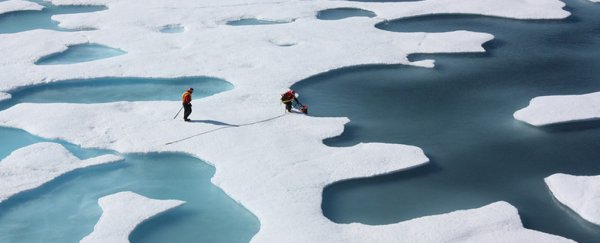New satellite data has revealed the Arctic is melting at a "frightening rate" due to the excess heat caused by human greenhouse gas emissions.
End-of-season Arctic multiyear sea ice – the ice that persists over several years – was roughly 50 centimeters (1.6 feet) thinner in 2021 than it was in 2019, the figures show, a drop of around 16 percent in just three years. It's being replaced by less permanent seasonal sea ice that melts completely every summer.
Over the past 18 years, Arctic Ocean winter sea ice has lost one-third of its volume – a staggering figure that may have been underestimated in the past, says the research. It's the first study to use years of satellite data to estimate both ice thickness and the depth of snow on top.
"Arctic snow depth, sea ice thickness and volume are three very challenging measurements to obtain," says polar scientist Ron Kwok, from the University of Washington.
"The key takeaway for me is the remarkable loss of Arctic winter sea ice volume – one-third of the winter ice volume lost over just 18 years – that accompanied a widely reported loss of old, thick Arctic sea ice and decline in end-of-summer ice extent."
The data comes from the ICESat-2 and radar CryoSat-2 satellites orbiting Earth.
What makes the study important is the way it combines the LiDAR technology of ICESat-2, which was launched three years ago, and the radar technology of CryoSat-2. While LiDAR uses laser pulses and radar uses radio waves, they're both detecting objects (in this case snow and ice) based on the reflections being bounced back at them.
Without this data, judging ice thickness is tricky, because of the way that snow can weigh ice down and change how it floats in the ocean. By using climate records to estimate snow depth in the past, scientists have been overestimating sea ice thickness by up to 20 percent or 20 centimeters (0.7 feet), the study suggests.
Multiyear ice is known to be thicker and therefore more resistant to melting than seasonal ice – you can think of it as sort of a reservoir for the Arctic.
As it becomes depleted and gets replaced by seasonal ice, the overall thickness and volume of Arctic sea ice is expected to quickly decrease as well.
"We weren't really expecting to see this decline, for the ice to be this much thinner in just three short years," says polar scientist Sahra Kacimi, from the Jet Propulsion Laboratory at the California Institute of Technology.
Combining previous records from the older ICESat satellite to look back 18 years, the researchers estimate that around 6,000 cubic kilometers (1,439 cubic miles) of winter ice volume has been lost across that time span.
That the last three years has seen a sharp drop is also concerning. Less ice means massive disruption for ecosystems. It could eventually alter the pivotal ocean currents we all rely on, and most likely also accelerate the climate change that's happening all around us.
Reducing our fossil fuel emissions is the only way we can stop this and we can all still play a more powerful role than we probably realize. Even our perceptions can make a difference.
Meanwhile, it's promising that the newer ICESat-2 satellite, launched in 2018, is working as intended, and we're getting more data back about Arctic ice levels than ever before – even if it makes for grim reading.
"Current models predict that by the mid-century we can expect ice-free summers in the Arctic, when the older ice, thick enough to survive the melt season, is gone," says Kacimi.
The research has been published in Geophysical Research Letters.
